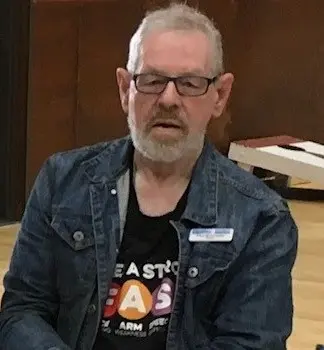Paul's story

My name is Paul Burroughs. I am a 74-year-old stroke survivor of two strokes. My first stroke was in March 1993 when I was 42 years old.
I was serving on a jury in the Hamilton District court in Hamilton in March 1993 when I suffered a haemorrhagic stroke due to undiagnosed high blood pressure which caused a brain aneurysm to bust and cause a brain bleed. I was not aware of what was happening apart from having a severe case of pins and needles on my left side leg, arm and face while sitting in the jury box.
At the first morning break, when the jury was sent back to the jury room, I could not stand up to let the person beside me move out of the jury box. They asked me what the problem was and when I explained the person next to me, who happened to be a nurse, realised I may have been having a stroke and said to the Judge, “I think you had better call an ambulance. I think this man is having a stroke.” So, fortunately for me, I was taken to the Waikato Hospital very quickly where staff did a CT Scan and established that I was indeed having a brain bleed. The medical staff then took action to stop the bleed and control my blood pressure in the ICU Ward and, once stabilised, I was transferred to the stroke ward at Waikato Hospital where I remained for around six weeks before being discharged home with left side hemiplegia and diminished peripheral vison on the left side.
I became aware of Stroke Aotearoa while in the stroke ward at Waikato Hospital because the occupational therapist took a number of people, including me, to the local Hamilton Stroke Club meetings as part of their preparation for discharge and rehabilitation back into the community following their stroke.
Following my discharge from the Waikato Hospital stroke ward, I had approx. 18 months of outpatient’s treatment with weekly physiotherapy and occupational therapy treatment to rehabilitate my left stroke affected side. The objective of being able to return to work in a packaging manufacturing plant where I worked prior to having my stroke. However, following two visits to my workplace with an occupational therapist, it was determined that it was not safe for me to be in the workplace. I was medically retired from my job once my sick leave, annual leave and long service leave expired.
As a reasonable fit 42-year-old, I had not had frequent contact with my GP, so I was totally unaware that I had high blood pressure until my first stroke. In 2000, I suffered another stroke caused by a clot this time. I have been feeling unwell so went to the GP who sent me straight to Waikato Hospital and it was established, following a CT scan, that I had had another stroke. I spent approximately ten days in Waikato Hospital this time and was discharged home again.
Over the period of a few years prior to 2017, I had been referred to a cardiologist at Waikato Hospital who had referred me to the catheterisation laboratory where they did a scan and determined that I had blocked arteries but was not suitable to have stents inserted. In August 2024, I had a heart attack and ended up back in Waikato Hospital where after a lot of investigating it was decided to do a triple heart bypass which was successful.
Following my stroke in 1993, I became involved with the local stroke peer support group, the Hamilton Stroke Club, and have been involved with that club since that time serving on the board and as the Secretary and currently the Treasurer and fundraiser.
I was also involved with the establishment of the regional organisation the Stroke Foundation Midland Region from its inception until its merger with the National Organisation “Stroke Foundation of New Zealand Ltd” and served on the Stroke Foundation National Council as the President of the Stroke Foundation Midland Region Inc.
This period is documented in the book by John Howard “A brief look at the Stroke Foundation of New Zealand Inc 1979 –2012” which traces the establishment of the Stroke Foundation and its evolution to the organisation it is today.